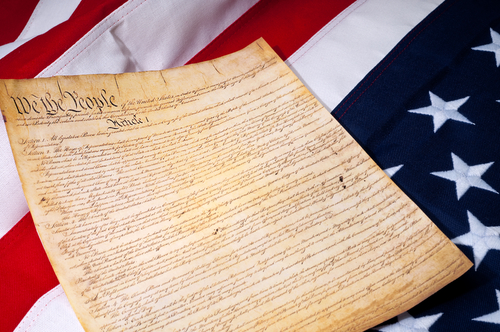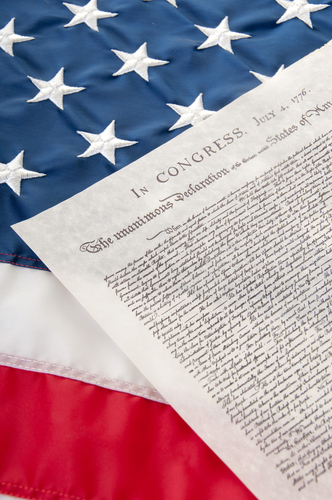Table of Contents

10th Amendment Overview
The Tenth Amendment to the United States Constitution, ratified in 1791 as a part of the Bill of Rights, reads as follows: “The powers not delegated to the United States by the Constitution, nor prohibited by it to the States, are reserved to the States respectively, or to the people.” This one sentence has had a significant impact on the course of American history and the relationship between the federal government and individual states in the country.
The Tenth Amendment is often referred to as the “states’ rights amendment,” and for good reason. It affirms that the federal government only has the powers specifically delegated to it by the Constitution, and that all other powers belong to the states or the people themselves. This concept of limiting the power of the federal government in relation to the states was a core belief of many of the founding fathers, and remains a fundamental principle of American governance to this day.
One of the key ways in which the Tenth Amendment has influenced the United States is in its impact on the balance of power between the federal government and individual states. The Constitution established a federal system of government in which power is shared between the national government and the state governments. However, over time, the federal government has increasingly exerted its power over the states through various means, such as the creation of federal agencies and regulations.
The Tenth Amendment serves as a reminder that the federal government’s powers are limited by the Constitution, and that all other powers belong to the states or the people. This has been an important check on the power of the federal government throughout American history, and has helped to maintain the balance of power between the various levels of government.
Another way in which the Tenth Amendment has influenced the United States is in its impact on the interpretation of the Constitution by the Supreme Court. The Court has often used the Tenth Amendment as a basis for ruling in favor of states’ rights and against the overreach of the federal government.
For example, in United States v. Lopez (1995), the Supreme Court struck down a federal law that made it a crime to possess a gun within 1,000 feet of a school. The Court ruled that Congress did not have the authority to pass this law under the Commerce Clause of the Constitution, and that it intruded on the powers of the states. The Tenth Amendment played a key role in this decision, as it helped to establish that the federal government’s powers are not unlimited.
The Tenth Amendment has also been important in shaping the political and ideological landscape of the United States. The concept of states’ rights has been a powerful force in American politics, and has been used to argue against federal policies that many people believe infringe on the rights of states or individuals.
For example, in the 1960s and 1970s, the Tenth Amendment was invoked by opponents of federal civil rights legislation. They argued that the federal government did not have the power to interfere with the rights of individuals and businesses in the states, and that such laws were an affront to the principles of federalism and states’ rights.
Today, the Tenth Amendment continues to be invoked in debates over a wide range of issues, from gun control to healthcare policy to same-sex marriage. Those who believe in states’ rights often turn to this amendment as a way to argue against federal policies that they believe are overreaching or unconstitutional.
However, the Tenth Amendment has also been criticized by some as an outdated principle that has outlived its usefulness. Critics argue that it is unclear what powers belong to the states versus the federal government, and that the terminology used in the amendment is vague and open to interpretation.
Despite these criticisms, the Tenth Amendment remains an important part of the American political system, and continues to shape the debates and policy decisions of the country. It serves as a reminder of the importance of the principles of federalism and limited government, and helps to ensure that power is balanced between the various levels of government.
In conclusion, the Tenth Amendment has had a significant impact on the United States, both in terms of its impact on the balance of power between the federal government and the states, and in its influence on the political and ideological landscape of the country. While some may argue that it is an outdated principle, the Tenth Amendment remains a core component of American governance, and will continue to shape the direction of the country for years to come.
Deciphering the 10th Amendment: Exploring its Significance and its Impact on State Laws Across the United States
Introduction
The 10th Amendment to the United States Constitution holds a pivotal place in the framework of American governance, highlighting the concept of federalism and the division of powers between the federal government and the individual states. This amendment underscores the principle that powers not delegated to the federal government are reserved for the states or the people. In this comprehensive guide, we delve into the intricacies of the 10th Amendment, its historical context, and how all 50 states navigate the balance between federal authority and state autonomy within their respective laws.
Understanding the 10th Amendment
The 10th Amendment serves as a cornerstone of the Bill of Rights, ratified in 1791. It addresses concerns about the scope of federal power and the potential encroachment on states’ rights. While not a comprehensive limitation on federal authority, the amendment acts as a reminder that the federal government’s powers are enumerated and that states retain sovereignty over matters not explicitly granted to the federal government.
Historical Context and Intent
During the drafting of the Constitution, debates arose over the balance of power between the federal government and the states. The Founding Fathers sought to prevent the centralization of authority, drawing lessons from British colonial rule. The 10th Amendment emerged as a response to Anti-Federalist concerns, aiming to allay fears of a powerful, centralized government infringing upon individual liberties and state sovereignty.
The Scope of State Laws under the 10th Amendment
Across the 50 states, the 10th Amendment’s implications are reflected in varying ways within state laws. Let’s explore how some states approach the balance between federal and state authority while upholding the principles of the 10th Amendment:
Alabama:
Alabama’s state laws align with the 10th Amendment by emphasizing local control over education and criminal justice. The state entrusts education policy to local school boards and maintains its criminal code, exemplifying the reservation of powers to the states.
Alaska:
Alaska upholds the 10th Amendment by asserting control over land and resources within its borders. The state’s regulatory framework for natural resource management showcases the extent to which states retain authority over issues not explicitly granted to the federal government.
Arizona:
Arizona emphasizes its sovereignty under the 10th Amendment by challenging federal immigration policies. The state’s laws and regulations pertaining to immigration enforcement underscore its stance on state prerogatives in areas that fall within its jurisdiction.
Arkansas:
Arkansas mirrors the 10th Amendment’s intent by preserving its authority over healthcare decisions. The state’s approach to Medicaid expansion and healthcare policies reflects its commitment to determining healthcare solutions that align with its citizens’ needs.
California:
California navigates the balance between federal and state authority under the 10th Amendment by adopting stringent environmental regulations. The state’s emphasis on environmental protection demonstrates its autonomy in shaping policies that address local concerns.
Colorado:
Colorado’s marijuana legalization laws showcase the state’s interpretation of the 10th Amendment. The state’s decision to legalize and regulate recreational marijuana underscores its assertion of authority over matters that impact its citizens’ choices and values.
Connecticut:
Connecticut’s gun control legislation illustrates the state’s commitment to exercising powers not delegated to the federal government. The state’s approach to firearm regulations underscores its belief in the ability to tailor policies to its unique circumstances.
Delaware:
Delaware’s corporate law framework aligns with the 10th Amendment’s principles. The state’s well-established reputation as a corporate haven highlights its authority to craft business regulations that attract companies and stimulate economic growth.
Florida:
Florida’s educational policies reflect its interpretation of the 10th Amendment. The state’s autonomy in setting curriculum standards and education policies demonstrates its commitment to determining the best educational approaches for its students.
Georgia:
Georgia’s state laws emphasize the 10th Amendment’s intent through its approach to criminal justice reform. The state’s initiatives, such as reducing mandatory minimum sentences, highlight its authority to address criminal justice matters in a way that best serves its communities.
Hawaii:
Hawaii’s management of natural resources exemplifies the state’s interpretation of the 10th Amendment. The state’s commitment to preserving its unique environment and cultural heritage highlights its authority to make decisions that reflect its citizens’ values and interests.
Idaho:
Idaho’s state laws demonstrate its adherence to the principles of the 10th Amendment through its approach to land use and conservation. The state’s authority to manage its natural resources and protect its lands showcases its commitment to asserting its sovereignty in areas that directly impact its communities.
Illinois:
Illinois’ gun control legislation reflects the state’s understanding of the 10th Amendment’s role in shaping state laws. The state’s measures to regulate firearm possession and sales emphasize its authority to address public safety concerns in a manner that aligns with its citizens’ needs.
Indiana:
Indiana’s emphasis on religious freedom protections showcases its interpretation of the 10th Amendment. The state’s laws and policies that safeguard religious expression exemplify its commitment to preserving individual liberties and asserting its authority over matters of conscience.
Iowa:
Iowa’s role in shaping agricultural policy underscores its interpretation of the 10th Amendment. The state’s ability to craft regulations and incentives that promote sustainable farming practices reflects its commitment to addressing economic and environmental challenges within its borders.
Kansas:
Kansas’ approach to education policy demonstrates its commitment to the 10th Amendment’s principles. The state’s authority to set curriculum standards and determine educational priorities underscores its belief in tailoring educational approaches to its citizens’ needs and values.
Kentucky:
Kentucky’s emphasis on states’ rights is evident in its criminal justice policies. The state’s approach to sentencing reforms and re-entry programs reflects its authority to shape laws that align with its citizens’ well-being and reduce recidivism.
Louisiana:
Louisiana’s management of its coastline and natural resources showcases its understanding of the 10th Amendment’s significance. The state’s commitment to preserving its unique environment while balancing economic interests underscores its authority to address complex issues within its borders.
Maine:
Maine’s healthcare policies reflect the state’s interpretation of the 10th Amendment. The state’s approach to Medicaid expansion and healthcare delivery demonstrates its authority to address public health concerns in a way that suits its population’s needs.
Maryland:
Maryland’s gun control laws underscore the state’s commitment to the 10th Amendment’s principles. The state’s authority to enact firearm regulations that reflect its urban-rural divide and prioritize public safety exemplifies its autonomy in addressing issues that impact its communities.
Massachusetts:
Massachusetts’ environmental regulations highlight the state’s understanding of the 10th Amendment’s role. The state’s approach to protecting its natural resources and mitigating climate change underscores its authority to shape policies that align with its citizens’ values.
Michigan:
Michigan’s labor laws showcase the state’s interpretation of the 10th Amendment. The state’s authority to regulate labor practices, collective bargaining, and workers’ rights exemplifies its commitment to addressing economic and social challenges in ways that resonate with its citizens.
Minnesota:
Minnesota’s educational policies reflect the state’s commitment to the 10th Amendment’s principles. The state’s authority to establish curriculum standards and allocate education funding underscores its belief in tailoring educational approaches to its diverse student population.
Mississippi:
Mississippi’s role in shaping civil rights protections highlights its understanding of the 10th Amendment’s significance. The state’s authority to enact laws that reflect its history, values, and social dynamics underscores its autonomy in addressing complex issues within its borders.
Missouri:
Missouri’s approach to criminal justice reform demonstrates its commitment to the 10th Amendment’s principles. The state’s authority to enact sentencing reforms, diversion programs, and re-entry initiatives reflects its belief in addressing societal challenges in ways that resonate with its communities.
Montana:
Montana’s management of public lands and natural resources underscores its interpretation of the 10th Amendment. The state’s authority to regulate land use and protect its environment exemplifies its commitment to addressing economic and environmental concerns within its borders.
Nebraska:
Nebraska’s agricultural policies reflect the state’s understanding of the 10th Amendment’s role. The state’s authority to shape regulations and incentives that promote sustainable farming practices and support rural economies underscores its autonomy in addressing agricultural challenges.
Nevada:
Nevada’s emphasis on states’ rights is evident in its approach to gaming regulations. The state’s authority to shape laws that govern gambling and entertainment aligns with its commitment to addressing economic and recreational interests within its borders.
New Hampshire:
New Hampshire’s role in shaping tax policy showcases its interpretation of the 10th Amendment. The state’s authority to levy taxes and manage its fiscal affairs underscores its autonomy in addressing economic challenges and shaping its revenue sources.
New Jersey:
New Jersey’s environmental regulations highlight the state’s understanding of the 10th Amendment’s significance. The state’s approach to protecting its natural resources, mitigating pollution, and preserving its coastline exemplifies its authority to shape policies that align with its citizens’ values.
New Mexico:
New Mexico’s energy policies demonstrate its commitment to the 10th Amendment’s principles. The state’s authority to shape regulations and incentives that promote renewable energy and address climate change reflects its autonomy in addressing energy challenges.
New York:
New York’s immigration policies underscore the state’s interpretation of the 10th Amendment. The state’s role in shaping policies that impact immigrant communities exemplifies its authority to address social and humanitarian issues within its borders.
North Carolina:
North Carolina’s understanding of the 10th Amendment is reflected in its approach to voting rights. The state’s authority to shape laws that govern voter registration, ID requirements, and election procedures exemplifies its autonomy in addressing electoral concerns.
North Dakota:
North Dakota’s role in shaping energy policies demonstrates its commitment to the 10th Amendment’s principles. The state’s authority to regulate energy production, distribution, and environmental impact underscores its autonomy in addressing energy challenges.
Ohio:
Ohio’s emphasis on states’ rights is evident in its approach to labor laws. The state’s authority to shape regulations that govern workers’ rights, collective bargaining, and workplace conditions aligns with its commitment to addressing economic and social interests within its borders.
Oklahoma:
Oklahoma’s management of natural resources highlights its understanding of the 10th Amendment’s significance. The state’s authority to regulate energy production, water resources, and environmental impact exemplifies its commitment to addressing economic and environmental challenges within its borders.
Oregon:
Oregon’s environmental regulations showcase the state’s interpretation of the 10th Amendment. The state’s approach to protecting its natural resources, mitigating pollution, and promoting sustainable practices underscores its authority to shape policies that resonate with its citizens.
Pennsylvania:
Pennsylvania’s role in shaping healthcare policies underscores its commitment to the 10th Amendment’s principles. The state’s authority to regulate healthcare providers, insurance, and public health initiatives exemplifies its autonomy in addressing public health concerns.
Rhode Island:
Rhode Island’s emphasis on states’ rights is evident in its approach to healthcare policies. The state’s authority to shape laws that govern healthcare access, insurance, and public health reflects its commitment to addressing medical and societal concerns within its borders.
South Carolina:
South Carolina’s understanding of the 10th Amendment is reflected in its approach to education policies. The state’s authority to set curriculum standards, allocate education funding, and regulate education quality exemplifies its autonomy in addressing educational challenges.
South Dakota:
South Dakota’s role in shaping criminal justice policies demonstrates its commitment to the 10th Amendment’s principles. The state’s authority to enact sentencing reforms, diversion programs, and re-entry initiatives reflects its belief in addressing societal challenges in ways that resonate with its communities.
Tennessee:
Tennessee’s management of healthcare policies underscores its interpretation of the 10th Amendment. The state’s approach to Medicaid expansion, healthcare access, and insurance regulations exemplifies its authority to address public health concerns within its borders.
Texas:
Texas’ emphasis on states’ rights is evident in its approach to immigration policies. The state’s role in shaping policies that impact immigrant communities and border security reflects its commitment to addressing social and security interests within its borders.
Utah:
Utah’s understanding of the 10th Amendment is reflected in its approach to land use and natural resource management. The state’s authority to regulate energy production, public lands, and environmental impact exemplifies its autonomy in addressing economic and environmental challenges within its borders.
Vermont:
Vermont’s role in shaping environmental policies demonstrates its commitment to the 10th Amendment’s principles. The state’s authority to protect natural resources, promote sustainability, and mitigate climate change reflects its belief in addressing environmental concerns that resonate with its citizens.
Virginia:
Virginia’s management of civil rights protections underscores its interpretation of the 10th Amendment. The state’s approach to enacting laws that safeguard individual liberties, address discrimination, and promote equality exemplifies its authority to shape policies that align with its citizens’ values.
Washington:
Washington’s emphasis on states’ rights is evident in its approach to environmental policies. The state’s role in shaping laws that govern environmental protection, resource management, and sustainability reflects its commitment to addressing ecological and economic interests within its borders.
West Virginia:
West Virginia’s understanding of the 10th Amendment is reflected in its approach to energy policies. The state’s authority to regulate energy production, resource management, and environmental impact exemplifies its autonomy in addressing energy challenges.
Wisconsin:
Wisconsin’s role in shaping educational policies demonstrates its commitment to the 10th Amendment’s principles. The state’s authority to set curriculum standards, allocate education funding, and regulate education quality reflects its belief in addressing educational challenges that resonate with its communities.
Wyoming:
Wyoming’s emphasis on states’ rights is evident in its approach to land use and natural resource management. The state’s role in regulating energy production, public lands, and environmental impact reflects its commitment to addressing economic and environmental concerns within its borders.
Conclusion:
The 10th Amendment’s influence on state laws across the United States underscores the intricate balance between federal authority and state autonomy. As states exercise their sovereignty over a myriad of issues—from education and healthcare to immigration and environmental protection—they reaffirm their commitment to the principles of federalism and the division of powers. The 10th Amendment continues to shape the evolving landscape of American governance, highlighting the diversity, resilience, and vitality of the nation’s legal framework.
Tenth Amendment: Principle of Federalism through the provision of powers not granted to the federal government nor prohibited to the individual states.
What is the Tenth Amendment?
The powers not delegated to the United States by the Constitution, nor prohibited by it to the States, are reserved to the States respectively, or to the people.
The Tenth Amendment Defined:
The Tenth Amendment is fairly similar to an earlier provision outlined in the Articles of Confederation which stated that each individual state shall retain sovereignty, independence, freedom while possessing every power, right, and jurisdiction that is not expressly delegated to the greater governing body of the United States. Following the ratification of the Constitution, framers wanted a similar amendment to limit the federal government to only powers delegated, meaning the denial of implied powers.
The First Amendment is a part of the Bill of Rights, which are the first 10 Amendments to the United States Constitution and the framework to elucidate upon the freedoms of the individual. The Bill of Rights were proposed and sent to the states by the first session of the First Congress. They were later ratified on December 15, 1791.
The first 10 Amendments to the United States Constitution were introduced by James Madison as a series of legislative articles and came into effect as Constitutional Amendments following the process of ratification by three-fourths of the States on December 15, 1791.
Stipulations of the Tenth Amendment:
The Tenth Amendment was instituted in the Bill of Rights to ensure that the federal government would only exercise the powers that were stated as permissible in the Constitution. All other powers that are not directly referred to in the United States Constitution were delivered to the individual states.
Commercial Clause: Clause within the Tenth Amendment stating that Congress has the power to regulate commerce with foreign nations, and among several states, as well as with Indian Tribes
The Taxing and Spending Clause: States that Congress possesses the power to lay and collect taxes, duties, excises, imposts, to pay debts and provide common defense and general welfare to citizens of the United States.
The Necessary and Proper Clause: States that Congress possesses the power to make all laws which are considered necessary and proper for carrying into execution as well as all powers vested by the Constitution.
Funding: The federal system effectively limits the ability of the federal government to use state governments as well as their funding to benefit the national government. That being said, Congress maintains the power to implement programs or to instill regulations, where there are sound justifications for the national government to utilize the States to become instruments of national policy.
The 10th Amendment is often cited and exercised for state laws concerning the use of medicinal marijuana, firearms, state taxes, and other laws which are unique based on individual state law.
State Timeline for Ratification of the Bill of Rights
New Jersey: November 20, 1789; rejected article II
Maryland: December 19, 1789; approved all
North Carolina: December 22, 1789; approved all
South Carolina: January 19, 1790; approved all
New Hampshire: January 25, 1790; rejected article II
Delaware: January 28, 1790; rejected article I
New York: February 27, 1790; rejected article II
Pennsylvania: March 10, 1790; rejected article II
Rhode Island: June 7, 1790; rejected article II
Vermont: November 3, 1791; approved all
Virginia: December 15, 1791; approved all
Georgia, Massachusetts, and Connecticut did not ratify the first 10 Amendments until 1939

























